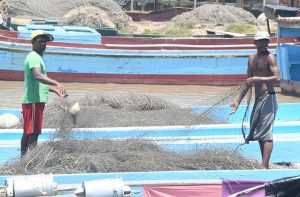–national fisherfolk organisation to be resuscitated this year
THE “rough tides” of 2020 were not enough to restrict progress in the fishing industry, which remained resilient throughout the year and even managed to secure revenue in excess of $16 billion.
Ecological challenges compounded by a protracted electoral process and a global pandemic made last year no easy one for stakeholders in the fishing industry, but, in the end, the traditional aspect of this industry raked in $16,033,405,740, while aquaculture mustered $207,251,016.
According to the Food and Agriculture Organisation of the United Nations (FAO), in Guyana, “capture fisheries” is undertaken by artisanal fishers and by an industrial fishing fleet composed of trawlers and hand-liners, including some foreign flagged, licensed vessels.

The organisation said most of Guyana’s fishing effort occurs in the relatively shallow waters of the continental shelf. In 2017, the estimated fleet comprised an estimated 1,498 vessels ranging in size from six to twenty-four metres, of which the great majority (83 per cent) were gill netters.
Aquaculture, on the other hand, has been practised for many years using mostly “low-input culture method” in brackish water and freshwater ponds, employing cachama, tilapia, and whiteleg shrimp as the major target species.
The consolidated contribution of both aspects of this industry accounted for two per cent of Guyana’s overall Gross Domestic Product (GDP) and 12 per cent of the agricultural GDP, in 2020.
Information shared with the Guyana Chronicle shows that production in the area of marine fisheries was just over 30,000 metric tonnes at the end of November 2020, but was projected to end the year at over 35,000 metric tonnes. Total production was just above 38,000 metric tonnes in 2019.
Last year, Guyana produced finfish (artisanal), finfish (industrial), red snapper, prawns, seabob (industrial), whitebelly, seabob (artisanal) and tuna. Of those varieties, finfish raked over $11 billion — the most revenue for this industry — while red snapper and seabob each earned stakeholders over $1 billion.
Production, in the aquaculture sector, up to November last year was 121,741 kilograms, but was projected to end the year at 137, 626 kilograms. Total production was just above 246, 919 kilograms in 2019. This sub-sector produces bashaw, black shrimps, hassar, mullet, querriman, tambaqui and tilapia.
The aquaculture sector in Guyana is still relatively small, with production occupying only about 350 hectares of land around the country. But, it was reported recently that the Government will be working towards making this sector globally competitive and a key contributor to economic growth, through several initiatives like the expansion of the Satyadeow Sawh Aquaculture Station and aquaculture zoning, both on land and in water.
Aquaculture, a component of the agriculture sector, is the process of rearing, breeding and harvesting of aquatic species, both animals and plants, in controlled aquatic environments like the oceans, lakes, rivers, ponds and streams.
STRONG POTENTIAL
“Aquaculture in Guyana shows strong potential since the country has relatively large acres of flat lands with suitable soil types and access to large quantities and good quality freshwater (water conservancies)… moreso there are existing drainage and irrigation infrastructure in some areas, sub-tropical temperatures for shrimp and fish production and good availability of agricultural/ fisheries by-products for the formulation and manufacturing of aqua feed,” Minister of Agriculture, Zulfikar Mustapha said in a recent report.
The FAO has already provided US$100,000 to Guyana in 2019, to strengthen the strategic and regulatory framework for inland fisheries and aquaculture development in Guyana.
The fisheries department, in collaboration with the FAO, is expected to convert a draft aquaculture regulation to a legal document in 2021. Compliance with this regulation and the relevant authorities like the Environmental Protection Agency, Veterinary Public Health Unit and the Guyana Livestock Development Authority will be requirements for aquaculture operations.
On a wider scale, the Government plans to improve the entire fishing industry through several initiatives, which include the resuscitation of the national fisherfolk organisation, improved fishing and licencing procedures, formation of an aquaculture association and increased monitoring and surveillance of Guyana’s waters.
There are also plans to update the country’s fisheries management plan to cover short-term achievable objectives, and revise the strategic plan for inland fisheries and aquaculture development and management in Guyana (2013-2018).
The fishing industry employs some 8,400 people in harvesting and 5,000 in processing and marketing, so more than 10,000 livelihoods depend directly on fishery, and many more benefit indirectly from fishing-related occupations such as boat building, gear supply and repair.
According to the FAO, a significant number of persons work in processing, distributing and selling fish and fish products in domestic markets. A high proportion of workers in processing, distribution and retail are women, and they are active in harvesting as well.



.jpg)










